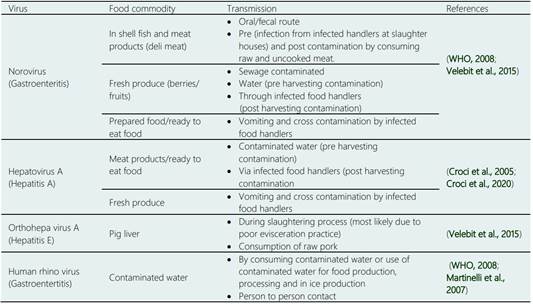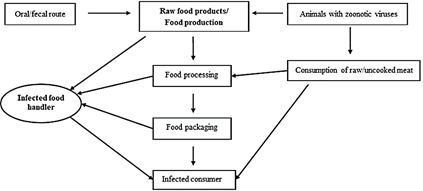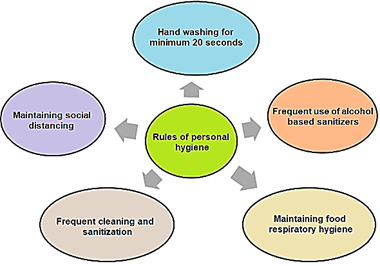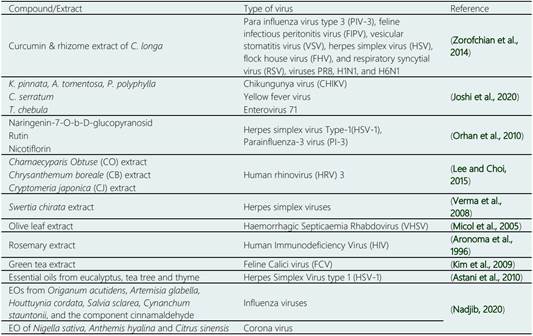1. Introduction
COVID-19 (SARS-CoV-2) belongs to a large group of corona virus family which causes severe respiratory illness. As per information, the first outbreak of corona virus originated from the seafood and animal market of the Wuhan city, located in the Hubei province, China in December 2019 (Wang et al., 2020) and further World Health Organization (WHO) officially declared it as a pandemic on 11 March 2010 (Sohrabi et al., 2020; Livingston, Bucher, & Rekito, 2020). According to the US Center for diseases control, the human corona virus was first identified in the mid-1960s. There are 7 human corona viruses from which four viruses (HKU1, NI63, OC43, and 229E) cause mild symptoms whereas others infect animals and can be transferred to human beings as new human corona viruses. Similarly, 2019 - nCOV (caused by SARS-CoV) is the recently identified virus from the zoonotic origin which enters into a category of human viruses, along with SARS-CoV (severe acute respiratory syndrome and MERS-CoV (middle east respiratory syndrome) identified earlier (Pressman, Naidu, & Clemens, 2020). The primary route for the transmission of coronavirus is human to human; close contact with the COVID-19 positive case can infect a large population by the spread of viral droplets through sneezing and coughing. The corona virus coated droplets (above 5µm) are too heavy to be airborne which results in the landing of these droplets on different objects and surfaces which further become possible sources of infection. Viral droplets (less than 5µm) increase the risk of airborne transmission by residing in the air for a longer period (Cook, 2020), airborne transmission of the SARS virus has been proved earlier (Yu et al., 2004).
This spread of the corona pandemic, along with human health and wealth, also affected the food sector (Silva-Jaimes, 2020). There is a continuous enormous increase in the infection of the COVID-19 globally with various reports of food workers all over the world getting infected. According to the reports of the US center for disease control among 1.3 lakhs workers from 115 meat and processing industries in 19 states of the US, 4913 confirmed cases were found with 20 deaths (Dyal, 2020). With the rapid spread of the infections, there aroused various myths like transmission of the virus can occur through the consumption of meat and poultry products. According to the survey done in Arabian countries, most of the people are not aware about the SARS-CoV-2 and concerned about the food related transmission, which emphasized the urgent need for the local authorities and government bodies to improve the level of information in controlling the false rumors about food and its safety (Faour-Klingbeil et al., 2021). However, there is no report to date that the virus was spread through the consumption of food although various gastrointestinal symptoms like nausea, vomiting, diarrhea have been reported (Wong et al., 2020). This review aimed to highlight the possible modes of transmission via food, impact of COVID-19 on food processing and innovations in food packaging that can be implemented to combat the spreading of infection through processed food products.
2. Modes of transmission of corona virus through food
Viruses are the intercellular parasite that requires a living host cell to replicate, where the host cell replicates its viral genome using its cell mechanism. This inert property of the virus does not allow culturing it in an environment free of the living cell. Due to the availability of limited diagnosing and analytical tools detection of virus become difficult (WHO, 2008). Norovirus (gastroenteritis), hepatovirus A (hepatitis A), orthoreovirus A (hepatitis E) are the most common food borne virus and can be transmitted to food commodity via various routes like contaminated water, oral-fecal route, infected food handlers. Table 1 shows the major routes of transmission of common food borne viruses (WHO, 2008; Velebit et al., 2015). Earlier outbreaks like SARS and MERS were not proven to be transmitted by food; similarly, no concrete evidence is available to date for SARS-CoV-2 also regarding such mode of transmission. Although, the transmission of SARS-CoV-2 through food is not scientifically proven but this does not rule out the possibility as SARS-CoV-2 is associated with animal trade and consumption (Ceylan et al., 2020;Yuan et al., 2020). The exposure of frozen fresh food to SARS-CoV-2 can also transmit the virus as it was found that MERS and SARS COV-1 can remain infectious in a frozen state for up to 2 years (Foote, 2020; Ghosh et al., 2020).
The transmission of the virus via food can take place during the handling in production, processing, packaging, and transportation. Cross-contamination from infected food handlers is one of the major routes of transmission (Velebit et al., 2019). The risk of spread of COVID-19 infection via food packaging through infected staff and then consumers have been already highlighted by the EU Commission (EU, 2020). Fig. 1 describes the various possible routes for transmission of COVID-19 via food.
3. Safety measures in food sector
On the alarming rise of the COVID infections among the people employed in the food sector, there was an urgent need to assure the safety of the people handling and delivering the food items. It became necessary for food operators and workers to maintain good manufacturing practices (GMP) and good hygiene practices (GHP). The food manufactures are continuing to follow food manufacturing practices (FMP) as per global food safety standards. To ensure the consistency in the quality and safety of food products there is focus attention on five key elements; people, premises, processes, products, and procedures along with attempting the basic rules of personal hygiene like washing hands, use of sanitizers and following social distancing guidelines (FDA, 2019; CDC, 2020). Fig. 2 shows the five basic rules of personal hygiene.
3.1 Measures for the operational bodies
Social distancing: The spacing marking for the workers was implemented for the assurance of maintenance of social distancing. Shift systems for the workers have been initiated where they are allowed to work in shifts to reduce the chances of mass gatherings.
Health monitoring: Fever, cough, headache, and shortness of breath are the early symptoms of COVID-19. It has been recommended to have a proper thermal screening of all the persons entering into the working area. The health status of the workers was also kept in the record so that people with severe cases of diseases like asthma, diabetes, or heart ailments and those who are feeling unwell not to be allowed in the working premises. This measure has been found to reduce the exposure of those people and also the risk for other persons getting affected with COVID.
Safety equipment: As per government guidelines, food workers were provided with safety kits containing face masks, hand gloves, sanitizers. Food operators were also advised to provide immunity boosters and banning the consumption of alcohol, tobacco, and other items that can deteriorate the health of their staff.
Sanitization of work premises: The sanitization process and proper cleaning play a major role in the food industries. Working areas, production areas, packaging areas, stores, and washrooms were sanitized and cleaned with soap, water, and disinfectants like 1% to 2% hypochlorite solution.
Informative sessions: Awareness sessions were taken to guide on COVID-19 symptoms, measures if affected and basic rules of personal hygiene as per the norms of different food safety standards.
3.2 Measures for the food handlers in food processing and packaging industries
To avoid touching of doors, lifts and use of biometrics.
Must be aware of how to maintain social distancing (at least a 2-meter gap) and proper wearing and disposal of safety equipment like masks, hand gloves, and PPE kits.
Must provide the details of their health status to the authority and follow proper isolation and quarantine rules if found to have flu-like symptoms.
According to the food packaging forum, proper washing of all the packaging must be done with soap and water (FPF, 2020)
Discard of the packaging after transferring packaged goods into clean containers for storage.
Quarantine the food items for up to three days before touching them.
The food handlers must follow the norms of WHO for proper sanitization.
Table 2 Safety measures for a) Handling of packaged food, b) Handling of fresh produce, c) Handling of food containers, d) Handling of grocery store produce
| Handling of packaged food | Meat, poultry, eggs, seafood and other perishable items should be refrigerated within 2 hours of purchase Disinfectants such as bleach and ammonia should not be used for hard surface packaging materials The soiled reusable bags should be washed and dried |
| Handling of fresh produce | The food products should not be washed with soaps, bleach, sanitizer, alcohol, disinfectant or any other chemical Fresh fruits and vegetables should be washed with cold or tap water The produce such as melons, cucumbers should be washed even if doesn’t have a plan to eat |
| Handling of food containers | Hands should be washed for at least 20 seconds by soap and water after handling food containers Clean utensils should be used to transfer the food to the dish Used surfaces should be cleaned after disposing the used containers |
| Grocery Store Produce | Fruits and vegetables should be washed by using running water before eating Hands should be washed properly by using soap and water after visit to a grocery store Reusable bags carried to and from the store should be cleaned and disinfected |
In case of leaks in the packaging material, the products should be transferred into a clean and sanitized secondary container that can be placed near the area of the carrying vehicle. If leaks occur, the surface should be thoroughly washed with hot, soapy water or a bleach solution in case it came in contact with raw meat, poultry or seafood, or its juices.
Table 2 exhibits the safety measures to handle packaged food, clean fresh produce, food containers, and grocery store produce. However, there is no evidence to date contracting the virus after touching food containers and packaged food.
3.2.1 Food supply and catering services
Food drug and administration (FDA) approved guidelines for the workers who are managing food pickup and delivery as handling and delivery of food items was found to be one of the root causes of the spread of infection (FDA, 2020).
Proper cleaning and sanitization:
Washing of hands with soaps for 20 seconds after sneezing, coughing, before and after using the washroom, before and after a meal, after touching surfaces like doorknobs and bells.
Use of alcohol-based sanitizer with at least 60 % alcohol in the unavailability of soap and water.
Proper and repeated cleaning of highly touched surfaces such as countertops and touch pads and parts of the vehicle.
Maintenance of social distancing:
Establishment of designated pickup zones for customers.
Offering no-touch delivery and sending of text alerts and calls after the delivery of food items.
Proper evaluation of identification and implementation of the operational changes for the maintenance of social distancing of 6 feet from others if possible.
Maintenance of food items:
Cold food must be kept cold by keeping enough coolant material like gel packs.
Hot food should be kept hot by ensuring the proper functioning of insulated cases.
Separation of food must be maintained to avoid cross-contamination e.g., raw food must be kept separate from cooked and ready to eat food.
Wrapping and packaging of food must be ensured during transportation to prevent the contamination of food.
Routinely sanitization of coolers and insulators used for the delivery must be done.
4. Impact on the food processing sector
With the spread of corona infection, various steps have been implemented by the government to mark a stoppage or to control the pandemic. Changes in consumers’ uncertainty demands and changes in their eating patterns resulted in the loss of various food processing sectors like dairy, sugar, meat, and poultry (Ceballos et al., 2020). In the process of taking safety measures, various countries across the world implemented stringent lockdown regulations that hard hit the dairy industry and thereby the socio-economic condition of the dairy workers. The price level of dairy products decreased due to the reduction in the demand for dairy products and due to a decrease in the export of dairy products (Sohrabi et al., 2020). Pandemic restrictions and measures made it difficult for sugar processing industries to operate. In India, the import and export of sugar have been severely affected and as the demand got reduced to 50%, there was a sharp decline in the production. The alcohol and jaggery production were adversely affected due to the decline in the sugar processing sector. Sugar processing industries was also hit due to a shortage of labors and consumables like packaging materials. Sugar mills struggled to pay the price to farmers and workers (Solomon et al., 2020).
Apart from the dairy and sugar industries, the meat and seafood industry are the other one that was largely hit due to this corona pandemic. The increasing report of corona positive cases and deaths in the meat and poultry industries resulted in the shutdown of plants. According to the article in food processing 13 May 2020, near about 20 industrial plants have been shut down in the US including Tyson foods, Plant in Waterloo, Lowa, other plants like JBS, Sanderson farms, Hormel foods, National beef, and Smithfield food after the reports of COVID -19 infections (Food processing, 2020).
The above facts created panic and rumors of the consumption of meat and seafood during the pandemic. WHO advised on reducing the visits to the live markets and meat consumption and asked to be cautioned against eating raw or undercooked animal products. To tackle the crisis during the pandemic, organized retailers invested heavily in the back-end processes which included introducing hygienic techniques of meat production and processing techniques for the floor level workers of the meat industry, training butchers, and educating them about clean meat production practices, processing, packaging, value addition and quality assurance (WHO, 2020).
5. Impact on food packaging
Although there is no report of transmission of COVID-19 through food and food packaging, importance of following good manufacturing practices GMPs to avoid the cross contamination and transmission of SARS COV -2 still holds good. An individual may get infected if touched surface or object, including food packaging. According to a report, the persistence of corona virus on plastic (72 hours) and steel (48 hours) is for a longer period than on the cardboard surface (24 hours). The persistence on the surface of copper (4 hours) is shorter possibly due to its antimicrobial actions (van Doremalen et al., 2020). During this pandemic, according to the report of the Food Packaging forum, the reusable system was claimed to be much safer than the single-use packaging system; however, it affects the target of zero - waste lifestyle. This might be true as it is not possible to trace the handling of the single-use packaging products whereas, on the other hand, reusable containers can be safe after proper washing with soap and water (FPF, 2020b).
Implementation of lockdown and enforcement of strict government rules resulted in the shutdown of dine-in restaurants. Although food delivery chains were operational consumers avoided that too, which in turn impacted the food packaging industry (WHO, 2020; Hobbs, 2020). As per survey in U.S. on COVID- 19 risk perceptions about food packaging and food delivered in restaurants, more than 50% consumers showed moderately concerned about the food packaging in dine in restaurant and near about 23% consumer population were found to be seriously concerned about the restaurant packaging of food (Byrd et al., 2021). According to the study conducted in china’s five-star hotels in response to their transformation from offline to online food delivery systems, people were much concerned about the packaging and delivery quality more than the taste, freshness and brand credibility (Yang et al., 2021). Near about $900 billion per year of the food packaging industry is on the front line worldwide, where the Corona pandemic showed the sharpest decline for eco-friendly food packaging market. According to a Jewish market report on 17 July 2020, the global eco-friendly food packaging market was valued at $163.5 billion in 2018 which was expected to gain revenue of $248.7 by 2026 but due to the current scenario, it reached only to 159.8 billion. Market analysts have projected that the market is expected to restore from the losses and grow significantly by the third or fourth quarter of the year 2022.
6. Future Innovations in food packaging - Antiviral food packaging
Food borne viruses are one of the major causative agents for food borne outbreaks. In 2010, 15% of food borne outbreaks reported virus as the causative agents (EFSA, 2012) and according to those reports, Human noro viruses (HuNoVs) and Hepatitis A virus (HAV) was found to be of the greatest concern in context to food safety. HEV was recently identified as a food borne virus causing zoonotic transmission from pork meat product to humans on consumption. Natural bioactive compounds (flavonoids, polyphenols, tannins, catechins, saponins, polysaccha-rides, proanthocynins, proteins and peptides) present in plant extract of cranberry, pomegranate, blue berry, black raspberry, grape seed extract showed a great extent of antiviral activities by destruction of viral structure or by preventing the entry of virus into the host body (D’Souza, 2014; Martínez-Abad et al., 2013). Other than plant extracts there are various essential oils, algal extracts, proteins which are reported as antiviral. Various algal products such as carrageenan, naviculan, laminaran are also found to have antiviral activity (Ahmadi et al., 2015). Various natural antiviral compounds are listed in Table 3.
In this decade, there are a lot of ongoing research on antimicrobial food packaging which aimed to increase the shelf life of food products and to retain food safety and quality. Antimicrobial packaging plays an active role in inhibiting microbial growth and spoilage. In the development of antimicrobial food packaging, there should be direct contact of the packaging material with the surface of the food for the migration of the antimicrobial compounds. Antiviral food packaging material aims to control the human enteric virus. Therefore, in the case of antiviral food packaging, it is necessary to inactivate the presence of the human enteric virus in food contaminated from raw and processed food products. Intrinsic material characteristics (which deals with polarity, chemical composition) responsible for release properties of the biocidal compounds (Fernández-Pan et al., 2015) and processing conditions for material development which directly affects its mechanical, thermal, and physical properties (which affect stability and release properties of the antiviral compound) are the relevant factors to be considered while designing antimicrobial packaging material (Efrati et al., 2014). However, there is less study with antiviral compounds into biopolymers due to its non-compatibility with polymeric structure and the quick release or degradation of antiviral agents.
(Martinez-Abad et al., 2013) developed 1% silver-PLA film and it was found to eliminate Feline calicivirus (FCV) from lettuce after 6 days of storage. Antiviral packaging materials were also developed by incorporating plant extracts in the biopolymers. A multilayer packaging material developed with cinnamaldehyde and zein ultrathin nanostructure layered covered with an outer layer of polyhydroxy-butyrate (PHB) worked against norovirus surrogates (Fabra et al., 2016). Chitosan is a promising candidate having excellent antifungal, antioxidative and antimicrobial properties to make coating or film. It was observed that chitosan coating or films reduced the food borne pathogens with the addition of essential oils or propolis into it (Torlak & Sert, 2013).
Recently, the chitosan matrix was utilized in a study for protecting (-) - epigallocatechin gallate (Gómez-Mascaraque et al., 2016) having antiviral activity against HAV & MNV.
Though only a few packaging materials have been developed which have antiviral activity, many of them were found to change the physicochemical properties of the food products. This can be controlled using edible films or coating. It is an emerging technology with controlled release of antimicrobial compounds by using various techniques like nanotechnology, encapsulation, and immobilization of antimicrobial agents from the matrix (Aloui & Khwaldia, 2016;Gomes et al., 2011). Antimicrobial edible coating or film can be developed by the addition of natural antimicrobial compounds in it which was observed to reduce food borne contamination. Though many literatures are available for antibacterial and antifungal compounds incorporation in edible coating no data is present regarding antiviral edible coating or films. Therefore, research on antiviral edible coating is expected to have great future. For making antiviral edible packaging materials, carvacrol, green tea extract, grape seed extract can be used as a natural antiviral agent. Similarly, many natural compounds such as clove, oregano which were found to have antiviral activity against MNV, FCV can be incorporated for the development of antiviral food packaging (Elizaquıvel et al., 2013). Micro and nano encapsulating sensitive antiviral compounds attracted many researchers. Indeed, it not only helps to stabilize the compounds but also enhance their activity. Encapsulation is found to increase the stability of antimicrobial compounds from even in irradiation (Gomes et al., 2011). Limited exposure has been given to the encapsulation of antiviral compounds and their food applications.
7. Conclusion
SARS-COV-2, a respiratory virus completely changed the scenario of food industries whether in production, processing or packaging. There is a need to understand the transmission route of SARS-COV-2 through food, where the street food and openly sold items are of the main concern. Though various trials for vaccination are in progress but there is a strict need to spread awareness regarding these pandemics to combat the various myths and rumors with the follow of SOP for personal hygiene to avoid cross-contamination. Various research has been done now in respect to antimicrobial food packaging but there is still a dearth in antiviral food packaging development. There is a great need to explore the antiviral food packaging incorporated with natural antiviral bioactive compounds to ensure both food safety and sustainability which will help in preventing our food system in these hard times of pandemic in future.



















